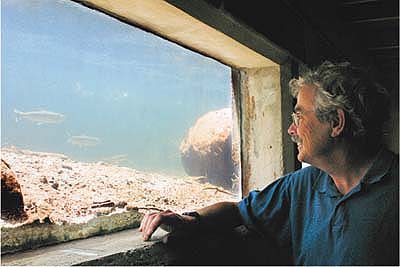All Issues
UC's Sagehen reserve is California's newest experimental forest
Publication Information
California Agriculture 60(2):47-48.
Published April 01, 2006
PDF | Citation | Permissions
Full text
Last November, the USDA Forest Service announced the designation of the 8,100-acre Sagehen Creek Watershed as an experimental forest. The announcement, made jointly with UC Berkeley, establishes Sagehen — located 8 miles north of Truckee — as the first new experimental forest in California in more than 40 years.
“Experimental forests have played a major role in improving the management of forest resources throughout the country,” says Alex Glazer, director of the UC Natural Reserve System, which oversees Sagehen and 34 other UC-operated research reserves throughout California. “This collaborative research program brings together managers and scientists with distinctive viewpoints and skills, but the common goal of achieving important, practical outcomes.”
The UC Natural Reserve System encompasses approximately 130,000 acres of protected natural land, which is available for university-level instruction, research and public outreach. The forest will be managed by the Tahoe National Forest, UC Berkeley and the Pacific Southwest Research Station.
Pioneering field research
UC Berkeley's Sagehen Creek Field Station, located on 452 acres within the Tahoe Basin, has been a center for pioneering field research for more than 50 years. In 1951, UC Berkeley professors A. Starker Leopold and Paul Needham first obtained permission from the Forest Service to establish a High Sierra facility for wildlife and fisheries studies.
Over the ensuing years, the professors and their graduate students literally built the station from the ground up. Each summer they would add new structures — laboratories, cabins, meeting rooms, a cookhouse — gradually creating a year-round research center.
Sagehen has proven to be an ideal area for study. Located at 6,380 feet on the eastern slope of the Sierra, the basin's complex topology and hydrology provide a mosaic of vegetation communities, including coniferous forests, montane chaparral, sagebrush steppe, wet and dry meadows, and spring-fed fens.
Initially, Needham and his students focused on fisheries while Leopold and his students studied wildlife, but succeeding generations of UC researchers expanded the focus to include the basin's fens, insects, flora, forests and hydrology.
Sierra-based studies
Several current projects will have important implications for the ecology of the Tahoe Basin. In one, UC Berkeley professors John Battles and Scott Stephens are heading up a Fuel Management National Pilot Project to evaluate the effectiveness of strategically placed area treatments (SPLATs) in reducing wildfire danger.
In another, UC Davis professor Peter Moyle and colleague Virginia Boucher are leading a study funded by the U.S. Fish and Wildlife Service on the restoration of native Lahontan cuttroat trout, using different strains of fish as well as different techniques for creating sustainable populations. “Sagehen is perfect for our study,” Boucher says, “because we have the best baseline data set on fish in the Sierra. It is also right next door to Independence Lake, which has one of the last sustainable wild cutthroat populations.”
A team of UC Berkeley researchers led by Inez Fong, with Sagehen faculty reserve manager Jim Kirchner, will focus on developing a deeper understanding of the life cycle of water on Earth. For example, small, automated “chemical laboratories” will be placed beside the streams to send back continuous chemical and isotopic measurements to identify the water's source.
“If we can relate the pattern through time as these chemical fingerprints change,” Kirchner explains, “we will be able to answer questions like whether streamflow during storms is coming from recent rainfall flowing into the stream quickly, or if it's coming from shallow runoff moving down hillsides and into the channel through the subsurface, or whether the new rainfall is pushing out old water from deep in the fissures between the rocks.”
UC Davis professor Peter Moyle, an expert in fish ecology, works with a team of graduate students at Sagehen Creek Field Station.
Jeff Brown, manager of the station, is confident that Sagehen can play a complementary role to other Tahoe-based research. “Sagehen Creek and Lake Tahoe are both part of the Truckee River watershed,” he notes, “yet here researchers can do manipulative studies that often can't be done within the Tahoe Basin itself. Research here will have impact throughout the Sierra and across the country.”






